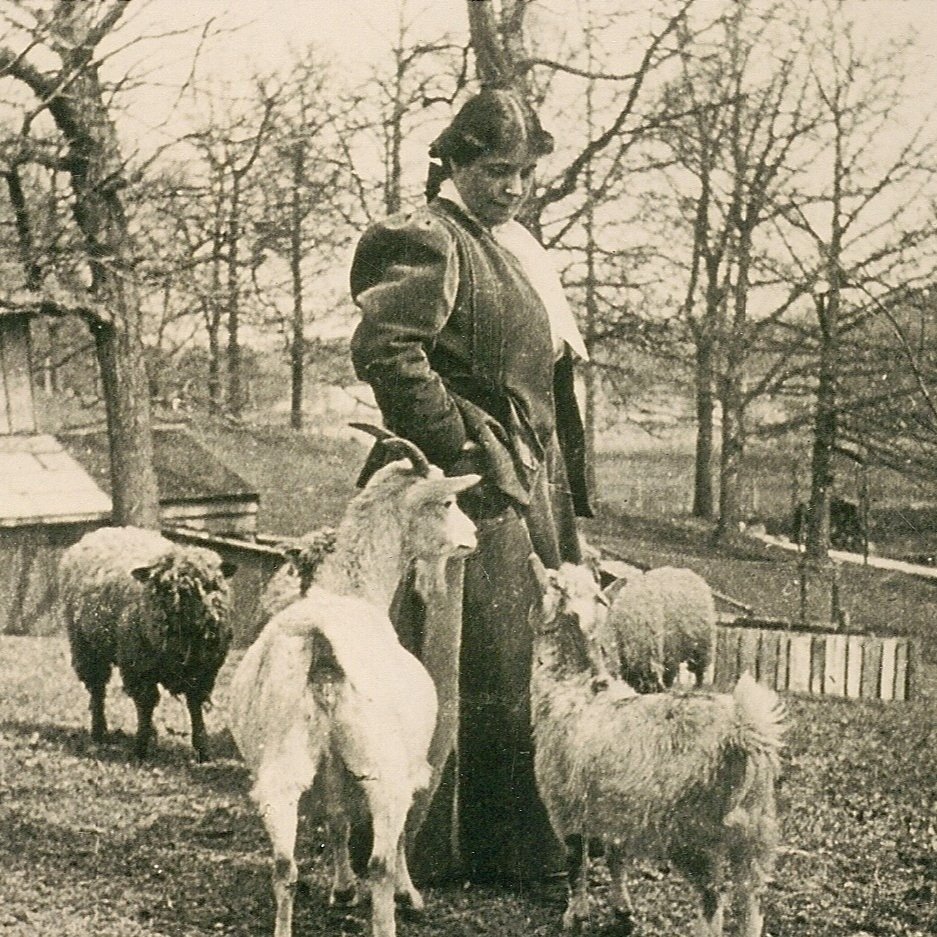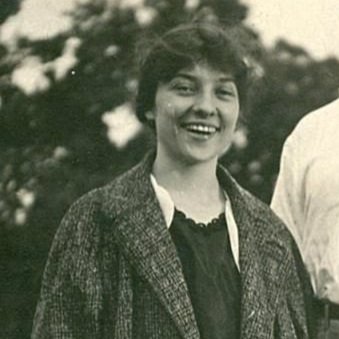The women who lived in the homes that are now museums in St. Charles and Geneva, Illinois made impacts locally, nationally, and even internationally. While often lesser known, they contributed significantly both to their communities while alive and to our understanding of the history of the Fox Valley after they were gone. For this Women’s History Month, we would like to share the stories of five of these women: Nelle (Wright) Fabyan and Elizebeth Smith-Friedman who lived at Riverbank (now the Fabyan Forest Preserve) in Geneva, and Jerusha (Shurtleff) Durant, Emma Louise (Durant) Lane, and Abba (Durant) Allen who lived in the 1843 Durant-Peterson House in St. Charles.
Nelle (Wright) Fabyan with her goats at Riverbank in Geneva by Burt Williams c.1930.
Nelle (Wright) Fabyan was born in 1866 and grew up in Wausau, Wisconsin. She married George Fabyan in 1891 and moved with him to Chicago in 1893 when he began working for his father’s dry goods and textile company, Bliss, Fabyan & Co. In 1905, Nelle bought a small farm of ten acres along the Fox River in Geneva which would soon grow to over 300 acres and become the Fabyans’ permanent home. While her husband spent his wealth hiring scientists to conduct a wide range of studies at their Geneva property, Riverbank, Nelle focused on running a profitable farming operation. In an interview she gave in 1920, Nelle explained, “I have always been fond of the out-of-doors… When I married and went to the city to live, it almost killed me. Hotel and apartment life smothered me; society bored me. I longed for the country… I’m never as happy as when tramping through the fields, a dog I like by my side.”[1]
Much of what was grown on her property was used to feed the staff, numbering as many as 100 at one point. However, as a shrewd businesswoman, Nelle also bred prize-winning Jersey cattle—the most famous of which was known as Ocean Blue—swine, poultry, and dogs, many of which she sold for top dollar. Greenhouses on the property produced high-quality flowers that were delivered to Chicago and sold all over the country. Nelle was also an artist creating concrete sculptures with the help of Italian sculptor Silvio Silvestri. At the first National Conference of Concrete House Construction, Nelle decorated a room with her concrete work that the Chicago Tribune described as “stands out in pleasing contrast to the other booths of the Cement show.”[2]
Learn more about Nelle Fabyan at the Geneva History Museum on March 12, 2024 at 12pm.
Elizebeth-Smith Friedman at Riverbank Laboratories in Geneva, IL c.1916.
Elizebeth Smith-Friedman was born in 1892 and grew up on a farm near Huntington, Indiana. She earned an English Literature degree from Hillsdale College in 1915 and found herself at the Newberry Library in downtown Chicago the following year for a job opportunity in Shakespearean research. This opportunity turned out to not be with the library, but in Geneva at Riverbank Laboratories for the wealthy Colonel George Fabyan. The Colonel tasked Elizebeth and over a dozen other women to work under Elizabeth Wells Gallup to discover and solve a cipher by Sir Francis Bacon that was believed to be hidden within William Shakespeare’s writing. If true, the Colonel and Gallup believed the cipher would reveal that Bacon was the true author of Shakespeare’s work.[3]
During her work at Riverbank, Elizebeth met William Friedman, a plant geneticist Col. Fabyan had hired for his farming experiments but began working on the cipher project with Elizebeth. When the United States entered World War I in March of 1917, there was a tremendous need for codebreakers that the Army simply did not have. Colonel Fabyan offered his code-breaking team in Geneva and for the next nine months, Riverbank Laboratories received and broke all codes sent to it by the U.S. military, led by Elizebeth Smith and William Friedman. The two married at Riverbank on May 21, 1917.
After the war, Elizebeth went on to work for the Coast Guard to break the codes of liquor smugglers during Prohibition and then, during World War II, she worked on a team hunting down Nazis in South America. Due to their extensive and early work in codebreaking, Elizebeth and her husband are known as the founders of the modern science of cryptoanalysis.
Learn more about Elizebeth Smith-Friedman at the Geneva History Museum on May 14, 2024 at 12pm.
Jerusha (Shurtleff) Durant. Photo from Richard Anderson.
Jerusha (Shurtleff) Durant was born on December 3, 1818, in the township of Stanstead – a small strip of land located between Vermont and Canada. In October of 1834 Jerusha’s father left the family to go west on his own to earn money to buy new farmland. The rest of the family moved to Massachusetts while Jerusha and her older sister, Orrillia, stayed in a boarding house and worked at a textile mill. The following year, her father returned to move the family to Genoa, Illinois where he had purchased 100 acres. Jerusha and Orrillia remained working at the textile mill until 1841 when they had enough money to travel west to be with the family again.
Jerusha met Bryant Durant after she moved to Illinois and the two married in November of 1843. They moved into a two-story brick home Bryant built on his 160-acre farm (now part of the LeRoy Oakes Forest Preserve). Jerusha and Bryant were blessed with six children – Julia, Henrietta, William, Emma, Abba, and Charlie.
Life on the farm was not easy and Jerusha was bothered regularly with headaches, illnesses, and fever. From the diary that her daughter, Abba, kept, it seemed that Jerusha was not a strong and healthy person – like their father.[4] But Jerusha always “put on a good face” and stayed active in the household, on the farm, and in the community. Jerusha and Bryant were deeply religious and were members of the Congregational Church and “went to meeting” regularly. In 1880, after all their children moved away, the Durants rented their farm to Godfrey Peterson and moved in with their daughter, Emma, in downtown St. Charles. Jerusha lived until 1900 and died at the age of 82.[5]
Emma Louise (Durant) Lane at approximately age 17, c. 1869.
Emma Louise (Durant) Lane was born in 1852 in a brick house near Ferson Creek in St. Charles built by her father in 1843. She was one of six children of Jerusha and Bryant Durant who grew up in the house. At the age of 18, she attended the Scammon Teachers College in Chicago and began teaching in St. Charles the following year. On and off for a total of 26 years from 1871 to 1915, Emma taught in St. Charles, Batavia, and Dundee. Much of what we know about the Durants and life on the Illinois prairie in the nineteenth century is from her life story which she wrote about from 1895 until she died in 1922.[6]
Contact Preservation Partners of the Fox Valley if you are interested in reading Emma’s diary.
Abba (Durant) Allen aged 17, 1871.
Abba (Durant) Allen was born in 1853, the second youngest of the six Jerusha and Bryant Durant children. Abba’s diaries, published in 1978, began on January 1, 1866 when she was twelve years old. She contributed regularly to her diaries from 1866 to 1875 and then began writing again in 1919 until she died in 1933. Her entries, particularly from 1866 to 1875, provide an enormous amount of contemporaneous detail of day-to-day life on a farm on the Illinois prairie. She wrote nearly every day through 1867 with short, matter-of-fact entries such as “Monday, July 30, 1866. It is very warm. I am more hateful then (sic) ever to day. [W]e are very busy sewing. [T]he machine does not work at all well. We were sorry. We wanted to finish Julie's things to night.”[7] Her entries became less frequent after 1867 but more detailed. Most fascinating about the publication of her diaries was the detailed index that helps the reader quickly find information about specific topics of prairie life that can be shared with visitors to her family home, the Durant-Peterson House Museum.
Thank you for reading! If this story interested, inspired, or informed you, please consider subscribing to our monthly e-newsletter so more of these stories come right to you!
[1] Margaret Foley, “The Farm and the Woman,” The Green Book Magazine 24, no. 6 (December 1920): 30, Internet Archive, https://archive.org/details/sim_green-book-magazine_1920-12_24_6/mode/2up.
[2] “Cement Art,” Chicago Tribune, February 10, 1917, ProQuest Historical Newspapers.
[3] Amy Butler Greenfield, The Woman All Spies Fear: Code Breaker Elizebeth Smith Friedman and her Hidden Life (New York: Random House Studio, 2021); Jason Fagone, The Woman Who Smashed Codes: A True Story of Love, Spies, and the Unlikely Heroine Who Outwitted America’s Enemies (New York: HarperCollins Publishers, 2017). Spoiler Alert: A cipher from Bacon was never found in Shakespeare’s writing.
[4] Abba (Durant) Allen, The Diaries of Abba (Durant) Allen, (1853-1933): St. Charles, Illinois, 1866-1875 and Logan, Iowa, 1919-1933, ed. Alexander G. Rose III (Baltimore, 1978), 15, Illinois Digital Archives, https://www.idaillinois.org/digital/collection/stc/id/11008/rec/2.
[5] Catherine Durant Voorhees, The Home Tree: Jerusha’s Journal (Bloomington, Ind.: AuthorHouse, 2012); Also, genealogy work by Kathy Steberl.
[6] Emma (Durant) Lane, The Diaries and Memoirs of Emma (Durant) Lane (1852-1922), St. Charles, Illinois: 1870-1922, ed. Alexander G. Rose III (Baltimore, 1978), Preservation Partners of the Fox Valley Archives, St. Charles, Illinois.
[7] Abba (Durant) Allen, The Diaries of Abba (Durant) Allen, (1853-1933): St. Charles, Illinois, 1866-1875 and Logan, Iowa, 1919-1933, ed. Alexander G. Rose III (Baltimore, 1978), 15, Illinois Digital Archives, https://www.idaillinois.org/digital/collection/stc/id/11008/rec/2.





